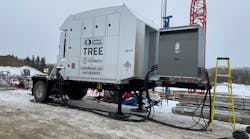State Route 11 in Northwest Washington is hailed consistently by travel writers as one of the most scenic routes in the state, if not the nation. Better known as Chuckanut Drive, the two-lane highway passes through picturesque farmland north of Burlington, WA, before climbing onto the westernmost slopes of the Chuckanut Mountains. There, motorists enjoy glorious views to the west of Puget Sound and the San Juan Islands at every turn in the twisty route that leads to the Fairhaven district of Bellingham, WA.
About 12 miles of the route, from Windy Point near Blanchard, WA, at the south end, to Chuckanut Bay at Bellingham, runs for the most part in a roadbed that was cut and blasted out of the mountainside in the early 20th Century. On sunny summer days, it is not unusual for the route to be packed with motorcyclists, sports car enthusiasts and tourists driving rental cars. But traffic drops off in the dark months due to poor visibility and the threat of icy patches and rock slides.
This season was no exception. On Nov. 10, a rockslide dropped boulders the size of cars onto the roadway at Milepost 13.3. That, however, wasn't the start of the problems on that hillside, said Ric Willand, a maintenance supervisor for WSDOT.
"A year and a half ago I noticed a 1-inch crack," he said. "We started watching."
Willand was on his way to inspect the site of a Nov. 7 slide when he found a few rocks in the road at MP 13.3. Looking up about 80 feet, he saw the crack had grown to a foot wide, he said. While he was there, more rocks fell.
"It's scary hearing that sound of rocks hitting the road," he recalled.
Willand and his team immediately closed the road as a precaution. It was a smart move, as it turned out, because the slope collapsed less than two hours after the closure, dumping 300 to 400 tons of rock and debris onto the roadway.
"The Chuckanut formation is the problem," said Doug Anderson, a WSDOT engineer geologist. "It's made up of sedimentary sandstone with inner beds of shale. "We're on a limb of anti-climb here. The bedding dips into the slope, and the anti-climb creates tension over the mound. ... Typically, the coal seams expand due to temperature or rain."
This can cause slides in both summer and winter, he explained.
Numerous fossils were exposed in the Nov. 10 slide. WSDOT photo.Five-Step ProcessGranite Northwest Inc., Everett, WA, was already working on clearing the earlier slide when the Nov. 10 collapse occurred. Its crew sent an excavator to the new slide to begin clearing the debris.
Eric Hanson, WSDOT project inspector, described the process for repairing the slide-prone hillside.
A scaling crew started the work by removing loose rock and debris from the hillside. This process is done partly by descending from above on ropes. Here, however, the steepness of the slope allowed scalers to access much of the hillside via a manlift set up on the roadway.
Next, post-tensioning bolts were drilled 25 feet into the hillside. A drill platform suspended from a 275-ton telescoping truck crane supplied by Ness Cranes, Seattle, facilitated this work.
When the bolts were in place, subcontractors Ragged Ridge Concrete Placing, Newman Lake, WA, and Corbett Concrete Pumping, Auburn, WA, proceeded to coat the hillside with a fiber-reinforced mix of shotcrete, supplied by Ferndale Ready Mix & Gravel Inc., Lynden, WA.
A Schwing DPL500 truck-mounted concrete pump conveyed the shotcrete to Mike Johnson, Ragged Ridge owner, and his assistant in the basket of a Genie S-125 lift for placement on the hillside.
With the slope stabilized, it was safe for Granite's crew to complete the removal of the slide debris. About 30 dump truck loads were hauled to a Skagit County site for processing so it can be used by the Parks Department for repairing trails and other applications.
The last step was to drill weep holes into the hillside and line them with PVC pipe. At the same time, seven 10-foot-long dowels were installed to support the shotcrete face. An Ingersoll Rand LM-100A drill powered by an Ingersoll Rand 600 compressor was brought to the site for this work.
When PB&E visited the job site a few days before Thanksgiving, Hanson noted the date.
"We have had three other slides since we started working on this one," he noted. "We've been busy here for a couple of weeks, and the season hasn't even stated."
Chuckanut Drive reopened to traffic on Dec. 9, 2008, after more than a month of closures, and has remained open since then.




